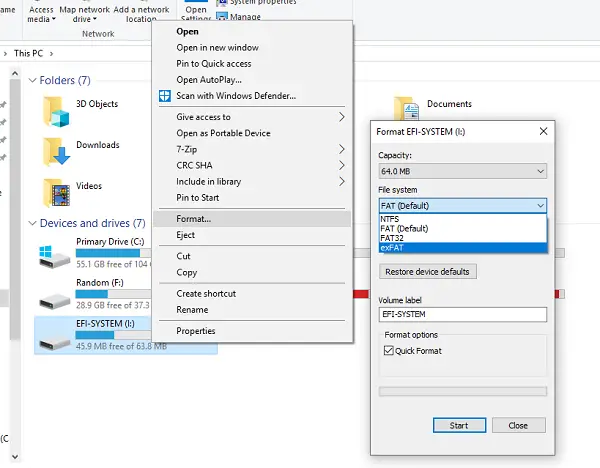


- Creating windows 10 usb fat32 or ntfs how to#
- Creating windows 10 usb fat32 or ntfs install#
- Creating windows 10 usb fat32 or ntfs iso#
Now copy the contents of the Windows ISO file to the flash drive. The UEFI_BOOT partition should appear as shown below: Hdiutil detach /Volumes/UEFI_NTFS (or eject the virtual disk) Then copy the contents from UEFI_NTFS to the UEFI_BOOT partition.Ĭp -R /Volumes/UEFI_NTFS/* /Volumes/UEFI_BOOT/ Hdiutil attach /path/to/uefi-ntfs.img (or double click the file) If using UEFI_NTFS download and mount the uefi-ntfs.img file. diskutil partitionDisk disk# 2 MBR "MS-DOS FAT12" "UEFI_BOOT" 1M ExFAT "Windows 10" R diskutil eraseDisk ExFAT "Windows 10" MBR disk#ī. Hdiutil detach disk# (or eject the virtual disk)įormat as exFAT with either a single partition (a) or two partitions if using UEFI_NTFS (b).Ī. Wimsplit /Volumes/Windows_DVD_Label/sources/install.wim /Volumes/WINDOWS\ 10/sources/install.swm 3800
Creating windows 10 usb fat32 or ntfs install#
Install wimlib with Homebrew or MacPorts and use wimsplit to divide and transfer the install.wim file. Now move the extracted files to the root of the flash drive. Rsync -avh -progress -exclude=sources/install.wim /Volumes/Windows_DVD_Label /Volumes/WINDOWS\ 10/ Hdiutil attach /Path/to/Windows.iso (or double click the file) Sudo diskutil eraseDisk FAT32 "WINDOWS 10" MBR disk# Substitute the correct disk and Windows DVD path below. Open Terminal and use "diskutil list" to identify your flash drive (example disk3 below) then prepare using one option below (FAT32 or exFAT).įormat as FAT32 with a single partition, mount the Windows ISO and copy all files except install.wim with rsync. Legacy/BIOS booting is unaffected by filesystems and can boot directly. If using exFAT you will likely need to boot the Windows installer from Clover or OpenCore or use the UEFI_NTFS bootloader from Rufus unless your firmware has native UEFI boot support for exFAT (see last section for details). NOTE: Recent releases of Windows 10 contain a file (install.wim) larger than 4GBs requiring it to either be split to accommodate the 4GB maximum file size limitation of FAT32 or the drive to be formatted as exFAT. Read carefully and download/install any required resources before attempting these procedures.ĭownload the Windows 10 ISO file and have an 8GB or larger USB flash drive ready.
Creating windows 10 usb fat32 or ntfs how to#
This procedure is intended as a replacement for " How to create a bootable Windows 10 USB in OS X using Terminal" as the technique described there is relevant to Linux hybrid ISO files (see references) but is unlikely to produce bootable Windows media. Windows 10 is described here but these instructions are valid for Windows 7/8. It can optionally be made BIOS bootable for legacy systems/installations as detailed below if desired. The resulting media will be bootable on any UEFI capable system which should be sufficient for the vast majority of computers in use today. This guide will detail the procedure to create a bootable Windows installer on a USB flash drive from either platform. Building a CustoMac Hackintosh: Buyer's Guide


 0 kommentar(er)
0 kommentar(er)
